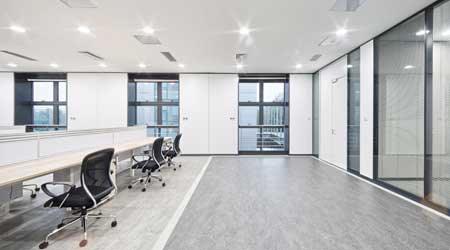 The acoustical quality of an open workplace is shaped by a wide range of building elements, including the type of ceiling, whether sound masking is being used, the type of partitions between workstations, if any, and how much exposed hard surface area there is.
The acoustical quality of an open workplace is shaped by a wide range of building elements, including the type of ceiling, whether sound masking is being used, the type of partitions between workstations, if any, and how much exposed hard surface area there is.Ceilings Selection Plays Crucial Role in Office Acoustical Environment
You're selecting a ceiling for more than just its acoustical properties. But understand how ceiling products can either help or hurt acoustics in your space.
Ceiling materials are an important factor in creating an optimal acoustical environment. The choice of what material is most appropriate depends on the type of office space. In open office space, the primary objective is to absorb sound; in private offices, the top priority is to block sound from being transmitted to and from adjacent spaces.
“There are some ceiling systems that don’t require choosing between absorbing and blocking because they can do both,” says Sean Browne, senior principal scientist at Armstrong World Industries. “These ceiling systems are especially helpful when reconfiguration of the space is likely due to changing requirements.”
In addition to ceiling products, acoustical material can be mounted on walls to absorb sound. This is especially important where a space has an exposed structure design and a wall-to-wall ceiling is not possible.
In an open office with exposed ceilings, blades, baffles, clouds, and felt shapes are all options available to facility managers.
Of course, acoustics isn’t the only factor that influences ceiling selection. A recent trend has been to move away from standard two-by-two and two-by-four ceiling tile installations and toward more customized and creative continuous and discontinuous designs, says Browne.
Integrated ceilings are packages that include acoustical panels and suspension ceilings, lighting fixtures, HVAC components, sprinklers, and the like. Manufacturer collaboration reduces complexity and increases interoperability.
“For example, if a lighting manufacturer has a linear light [with certain dimensions] we have grid systems, clips and peripherals available to make sure the light is going to fit,” Browne says. The end result is better acoustical performance and installation efficiency “because all of the components will have been tested and confirmed to fit properly and not require unnecessary alterations on the jobsite.”
When it comes to designing sound masking systems, it is important to make adjustment zones as small as possible, says Moeller. An unfortunate trend, in his view, is a move toward creating less flexible systems that increase the size of the adjustment zone. While such measures may reduce the cost of the system, there is a price to be paid in productivity, comfort, and speech privacy.
Small zone sizes and proper automated tuning are the most important factors to consider in setting up sound masking systems, Moeller says. Beyond that, some new options include a transducer, or a “type of speaker that mounts directly to the top of a gypsum ceiling and vibrates the ceiling, itself, making the ceiling into the speaker. The advantage is you no longer see a speaker that is cut through the ceiling.”
These speakers are affected by the material to which they are attached, which is why proper tuning is again important to provide optimal sound.
Many acoustical options are available for facility managers. Familiarity with these options, along with a clear understanding of the facility's needs, is necessary for them to choose products that will deliver optimal performance in a specific context.
Related Topics:














